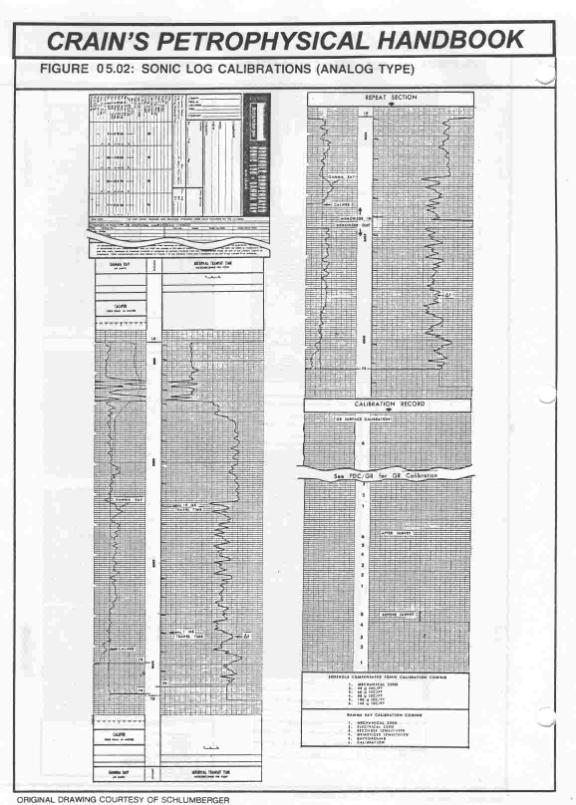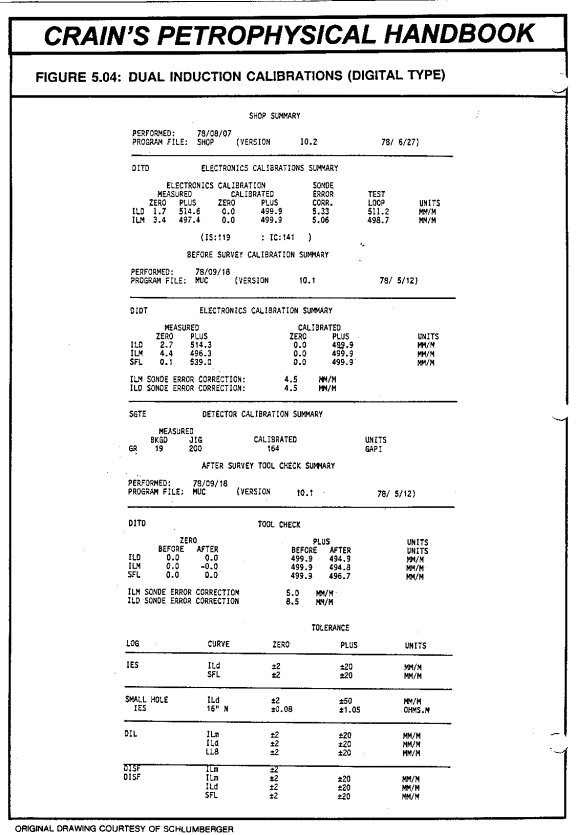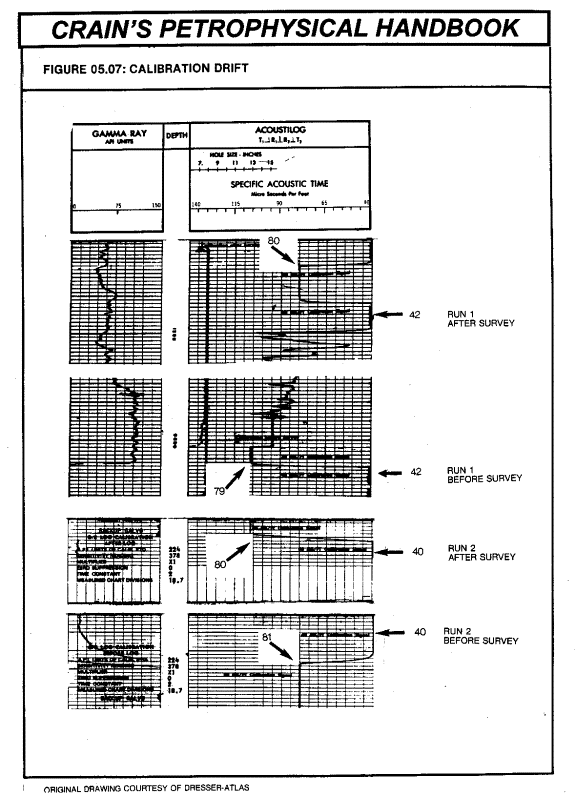|
 Log Calibrations
Log Calibrations
Calibrations are an integral part of any log. If they were
not run, or are now missing (or cut off the log), the
analyst should use extreme care in picking log values.
Standard calibrations for relatively modern logs (1960 to
present) are documented in service company manuals, which
should be part of your library. You will need dated versions
of these manuals as the current manuals will show only
current tools. This won't help for older logs in your files.
Two
calibration examples are shown below. The first is typical of
analog log recordings (1960 - 1975+/-) and the second is typical
of the digital log era. On analog calibrations, the calibration
steps for several log curves are shown on a log grid. For
digital logs, a computer printout will show the calibration
steps for various curves, as well as the permitted tolerance or
range of allowable values. Calibrations before and after the
survey, and in some cases shop calibrations are also attached.
Older logs (pre-1960) may have fewer, different, or no
calibrations shown. Calibrations for different service companies
vary slightly from each other, so be sure to obtain examples
from all service companies which you normally use.


Since
calibration details vary widely, it is impractical to publish all of
them in a handbook of this type. It is strongly recommended,
however, that you learn how to interpret and use calibration data,
such as those shown in the illustrations in this section.
Calibrations usually consist of low and high end points to define
the log scale, and intermediate points to define linearity of scale.
Primary calibration of a log usually occurs under laboratory
conditions or a test pit of known characteristics. Secondary
calibration is a method for carrying primary calibrations to the
service company field location by some device which simulates
the laboratory readings. These are usually called shop
calibrations. A third tier of calibration is a mechanism for
transporting shop calibrations to the field for use at each well
site.
For
example, a neutron log prototype is first calibrated in a test
pit with known rock type and porosity. Then it is immediately
run into a secondary calibrator of standard design, one of which
will be available at each major logging center around the world.
In the case of a neutron log, the secondary calibration is a
tank of particular dimensions filled with diesel fuel. The
readings in the secondary calibrator now constitute the main
source of calibration.
Periodically thereafter, each tool is placed in the secondary
calibrator, adjusted to read the correct response, and the field
calibrator is placed on the tool. The tool response to this
calibrator is then recorded. At each logging job, the tool is
readjusted to read the same value when in the field calibrator
environment. The field calibrator for a neutron log is a small
gamma ray source at a short distance from the neutron log
detector.
This
three stage process moves the primary calibration in the test
pit in Houston to each well logged by the tool. Some logs
require only a two stage calibration (such as induction logs)
and some only require one stage (such as spontaneous potential
or sonic travel time).
Calibrations performed before the log is run are called
Before-Survey Calibrations, and those run after the job are
called After-Survey Calibrations. Differences between Before and
After calibrations need to be accounted for only if the
difference is large enough to cause errors in the results of the
log analysis.
Even
though the logging engineer tries to perform calibrations
accurately and consistently, calibrations may be in error before
the survey starts or may drift from their set values due to
electronic problems. If these conditions prevail, the
calibrations are said to be shifted.

Several situations can arise if calibrations are clearly
shifted. Both before and after survey, calibrations may be off
by the same amount. Here, the log should be rescaled or a new
scale constructed to correspond to the calibrations. Most
computer aided log analysis software has a “block shift”
function to do this.
A
drift may occur between before and after calibrations. Here the
log must be rescaled at regular intervals to use up excess
drift.
For
example, assume a sonic log calibration showed the following:
| |
Low End |
|
High End |
| |
|
|
|
|
Before |
42 |
|
84
|
|
After |
43 |
|
82
|
|
Should have been |
40 |
|
80
|
|
If a
40 to 140 scale was used for the logged interval, and the log
was 3000 feet long, the following scales should be used:
|
Depth Interval |
|
Scale
|
| |
|
|
|
3000 to 2000 feet |
|
42 to 147 usec/foot |
|
2000 to 1000 feet |
|
42.5 to 145 usec/foot |
|
1000 to 0 feet |
|
43 to 143 usec/foot |
|
These values are created by linear interpolation or
extrapolation as required. Any log may be rescaled using linear
algebra. A computer can apply a continuous, linear or non-linear
shift as described by the user, providing the proper equation is
incorporated. Most computer aided log analysis software has a
“user-defined equation” function to do this type of
re-calibration.
All
induction resistivity and most laterologs logs should first be
translated into conductivity, rescaled, and then translated back
to resistivity. Most errors are in the sonde error setting,
which is a linear shift in conductivity, not in resistivity.
Calibrations may appear to be perfect, yet the log can read high
or low in comparison to other logs in the area. Checkpoints for
calibration shifts are the matrix base lines in clean,
non-porous limestone, dolomite, or anhydrite, shale base lines,
or overall position of the log curve with respect to another log
in the same or nearby well in thick shale beds with good
borehole conditions.
|

